#Cinema Village Manhattan
Text
Her Favorite Patient Screening at Cinema Village
I’m excited to share Her Favorite Patient will screen theatrically at Cinema Village on Sunday, 11/12 at 6:30 pm with seven other short films. Afterwards we will discuss making a film on a limited budget. The screening is presented by the New York Short Film Festival and the Filmshop collective. Tickets can be purchased here.
Her Favorite Patient screening
Sunday, 11/12 at 6:30 pm
Cinema Village
22 East 12th Street
New York, NY 10003
We hope to see you there!
Directed by Reuben Hernandez
Written by Brady Evan Walker
Starring Barbara Miluski (Girls, The Marvelous Mrs. Maisel) and Isabelle Pierre
#her favorite patient#Cinema Village#Cinema Village NYC#The Filmshop#filmshop#filmshopnyc#filmshop collective#Westbeth Artists Housing#Westbeth#westbeth artist#westbeth filmmaker#barbara miluski#barbaramiluski#Cinema Village Manhattan#film festival#NYSFF#New York Short Film Festival#thefil#thefilmshopnyc#reuben hernandez#ReubenHernandez#Reuben Hernandez Studios#reubenhernandezstudios#herfavoritepatient
1 note
·
View note
Photo


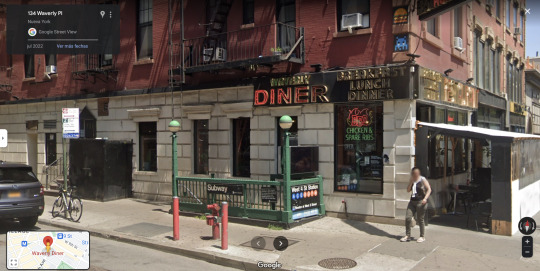
Love is Strange
Ira Sachs. 2014
Street
385 6th Ave, New York, NY 10014, USA
See in map
See in imdb
#ira sachs#love is strange#john lithgow#alfred molina#greenwich village#manhattan#new york#neon sign#waverly diner#movie#cinema#film#location#google maps#street view#2014
30 notes
·
View notes
Text





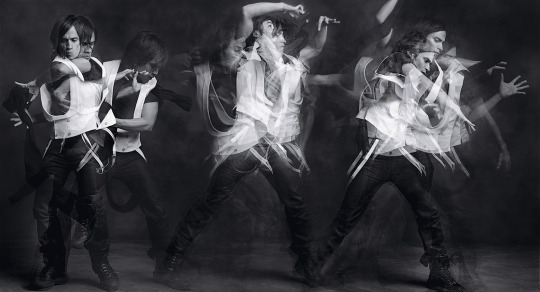

Gael García Bernal photographed by Craig McDean for AnOther Man in 2006.
Accompanying interview text (it's a really good interview) after the jump.
Interview by Dave Calhoun
(source but I can never get AnOther Man articles to display properly)
He played Che Guevara in The Motorcycle Diaries. He made a stunning drag queen in Bad Education. Now he’s a confused young Parisian who can’t distinguish between dreams and waking-life in The Science of Sleep, Michel Gondry’s latest mind-warp of a movie. He’s worked for some of the world’s top directors, from Pedro Almodóvar to Walter Salles. He’s fiercely political, a true film lover, and an actor who genuinely puts his art before his bank balance. He’s also a powerful force behind the new wave of filmmaking in Latin America. And Gael Garcia Bernal is still only 27.
Last night, Bernal was knocking back drinks and dancing late into the night at a house party in Greenwich Village. The morning after, he’s sitting in a small diner in downtown Manhattan, talking spiritedly about the disastrous effects that globalisation is having on rural farmers in his home country of Mexico.
“It’s getting to the point where it’s going to implode,” Bernal warns, knocking back a coffee. “The people who will be affected will be the poor. The countries who are going to get fucked up are the poor ones. It’s going to lead to civil wars.”
The more you speak to Bernal, the more time you spend in his company, and the more of his friends and collaborators that you speak to, the more you begin to understand that there’s something unusual about this young actor. There’s a refreshing, even old-fashioned, seriousness to the way he approaches his life and work. He’s unusually engaged – politically, culturally and socially – in a way that isn’t awkward or mannered. He’s hungry to learn, to work with the right people, to do the right thing, to make a difference. There’s a natural, confident ease in his commitment to cinema, politics and the world around him. If all this makes him sound too earnest, it shouldn’t; he’s as comfortable sniggering about beach parties in Brazil as he is dissecting politics. It’s all one life to him.
Bernal first grabbed the attention of the art-house crowd in 2000 in Alejandro González Iñárritu’s Amores Perros, an extreme story of three lives that collide in one car crash amid the chaos of Mexico City. He was 21. In the following year, he filmed the sexually charged road movie Y tu mamá también, which made him, alongside good friend and co-star Diego Luna, Mexico’s most in-demand young actor.
“We had finally discovered a new face,” remembers Carlos Cuarón, writer of Y tu mamá también and brother of the film’s director, Alfonso Cuarón.
“Here was a new young actor who could sustain emotion in a very different way. After seeing Gael in a short film a year or two before Amores Perros came out, I remember calling my brother and saying to him, ‘Man, you have to see this guy.’ He was like, ‘Yeah, thanks, I’m busy right now.’”
A year or two passed before Alfonso saw Gael in action. “Alejandro González Iñárritu is a friend of ours and he showed Alfonso an early cut of Amores Perros,” continues Carlos. “That was the moment when Alfonso said, ‘I want that guy!’ I was on the telephone saying, ‘I told you so!’”
Since then, Bernal has played a youthful Che Guevara in an award-winning performance for Brazilian filmmaker Walter Salles in The Motorcycle Diaries, a fox of a transvestite (and according to one critic a “dead ringer for Julia Roberts”) for the Spanish auteur Pedro Almodóvar in Bad Education, and opposite Charlotte Gainsbourg in French director Michel Gondry’s latest movie, The Science of Sleep. It’s an impressive roll-call of collaborators. And still not one Hollywood movie in sight.
“I think Tijuana is the closest I’ve ever got to Hollywood,” Bernal jokes as we talk about the three months he recently spent on location in the notorious Mexican border town for Alejandro González Iñárritu’s latest film, Babel. “It sounds like a really bad tragedy, doesn’t it? The Closest I Ever Got to Hollywood Was Tijuana!”
Carlos Cuarón agrees that Bernal’s acting path has been remarkable. “The really crazy thing about Gael is that he’s probably the most famous Mexican actor nowadays, but he still hasn’t done a Hollywood movie. He chooses his projects very intelligently. He picks them because he likes the director or because he thinks the script is amazing or because there are other interesting actors in the film. Usually, people become famous across the world because of Hollywood movies, he hasn’t had to go that route.”
Bernal’s commitment is thrown into sharp relief when he talks about his move to London to go to drama school at the age of 17 a decade ago. He was shocked by the country’s apathy to politics and culture. He expected the Rolling Stones, the Marquee Club and arthouse cinema. Instead what he found were the Spice Girls, Lock, Stock and Two Smoking Barrels, and students who would rather sit drinking in pubs or subject themselves to pharmaceutical testing than attend a political rally.
“I found it difficult coming from Mexico,” Bernal explains. “In Mexico, there’s this feeling that everything you do has a political complexity. Which it does. Whatever you do, whoever you say hello to, whichever part of the neighbourhood you go to... Everything has this huge political complexity, as well as social, emotional and sexual.
“I think my attitude also has something to do with my family. They work in the theatre, underground theatre, so maybe I was pretentious, or snobbish perhaps.”
Bernal’s teenage years coincided with a tumultuous time in Mexico. The country was emerging from what he labels “an old tyrant democracy”, and the Zapatista movement in Mexico’s southern state of Chiapas was rising up against the government. Street demonstrations were part of everyday life. Bernal and his family lived comfortably in Mexico City – his mother is an actor, his father an actor and director – but like many kids of his age he was swept up by the energy and sheer excitement of the capital’s mass support for the Zapatistas.
“That movement polarised the country, but it also united a lot of people,” Bernals recalls. “We helped to stop the war. Because of that, it felt like what we did counted. Something like a million and a half people demonstrated every day when the war between the government and the guerrillas started. I was very involved. I was writing and reading about the situation, helping to send food, and demonstrating on the marches. It was great. I was young, and it was fun. And, I’ve got to say, I met my first girlfriend – my first real girlfriend – there as well. It was a great place to meet girls!”
Sex and politics. There’s nothing po-faced about Bernal’s political engagement. It’s wrapped up in movies, fun, friendships, music, travel, theatre and family. There’s something pleasing and traditionally bohemian about all this. There is often a sense in Europe and North America, that we are too comfortable, cynical even, and few people believe that protest – let alone art – can make a difference. Bernal would get along just fine in Paris circa 1968.
All of which helps to explain why he spent the past ten days at the World Trade Organisation summit in Hong Kong. His world doesn’t end with himself and his films. In Hollywood, political engagement, more often than not, means rash gestures and red faces all round. Bernal’s engagement is more steady, more regular, more constant. He quietly attended the protests at the G8 summit in Edinburgh last year on the same weekend that Madonna, Elton et al performed at the Live 8 concert in Hyde Park. In Hong Kong, he sat in meeting after meeting, discussing ideas, presenting case studies and assisting delegates such as Mary Robinson, the former Irish president (“La Presidenta!” as Bernal calls her, laughing). Before travelling to Hong Kong, he spent some time in Chiapas, discovering for himself the effect that free trade is having on local maize and coffee producers.
He’s fully aware that his profile as an actor is a selling point for organisations such as Oxfam, but still he makes sure – indeed demands – that he’s fully informed. He’s not interested in being an intelligent pretty face. He wants to get stuck in. He arrived at the Hong Kong summit with an undefined role, but was soon speaking out at meetings.
“Little by little, I started to get into it and became really interested in everything,” he explains. “Oxfam asked me if I wanted to be in the talks and negotiations.”
He jokes about something else that he picked up at the summit, after some Germans he met fell about laughing when they heard his name. “Gael” it turns out, means “horny” in German. You can already see the pin-up poster tag-line in the German equivalent of Teen Vogue: “Ich bin Gael”, it would read, pasted across a brooding portrait of the actor. It wouldn’t be anything new. “Mexican heart-throb”, “Sex Mex”, “The sexiest thing to come out of Latin America since Ricky Martin” are just some of the tacky headlines – often in upmarket publications – that have been written recently about Bernal.
The conversation turns to Live 8. Bernal admits that he feels a strong sense of unease towards events like these.
“I was a bit critical of Live 8. The people that organised it act as if they are there to safeguard our souls, and present it as a civil action, as if it’s our civil duty to go to a concert. Many of the people who took part made no more effort to do this concert than they would to make a Pepsi commercial. Some of these artists are the same people who advertise Coca Cola. People in Mexico don’t have clean water, yet they’ve drunk Coca Cola all their lives. It’s cheaper to get a Coke than to get clean drinking water. That in itself is a strong image of how much power such companies wield across the world.”
Such independent thinking is present too in Bernal’s attitude to films and filmmaking. He’s happier on the margins, where the ideas and imagination lie. It’s interesting to contrast his career with the young American actors of a similar stature – those who, one minute are hailed as the new saviours of independent cinema, and the next, are dressing up as Spiderman or nestling happily in King Kong’s computer-generated fur. It’s easier to say yes than it is to say no, as Bernal has consistently replied to all approaches from Hollywood.
The screenwriter Milo Addica (Monster’s Ball and Birth) tells a good story about how Bernal accepted the lead role in The King, which he wrote and produced. It’s an independent American movie that British director James Marsh shot in late 2004. When the film was still in the casting stage, many young American actors read the script and liked it, but, as Addica recalls, backed off for what he calls “moral reasons”. They didn’t like the film’s violence or the ambiguity of a lead character who starts out as a hero, but commits an horrific act in the film’s closing moments. Bernal, on the other hand, leapt at the chance. He plays Elvis Valderez, a young American with a Mexican mother, who leaves the navy and goes in search of his father (William Hurt), a popular Baptist preacher who never knew his illegitimate son. It’s a search that ultimately has terrible consequences. Bernal does a good job in his first American film.
“We went to a number of young actors, all of who you know but I won’t name names,” Addica explains. “They all liked the script but were concerned with the audience’s perception. They wanted changes made to accommodate that. Of course, when you pay an actor $20 million he will do an Irish jig on the table for you. He doesn’t give a flying fuck.” Needless to say, $20 million was not on offer for The King.
Bernal is not easily tempted by a pay cheque. “A film with no point of view is such a waste of money,” he considers. “So much money is spent on films. Oh man, spend that money somewhere else!”
Bernal’s attitude to cinema is rooted in Mexico – rooted in the struggle to get films made – personal stories, real storytelling, strong ideas. He says that making The Motorcycle Diaries, for which he travelled through Argentina, Peru and Mexico, reaffirmed his commitment to Latin America and Latin American cinema. Last month, his production company in Mexico City opened for business in partnership with Diego Luna. They’ve already launched a travelling documentary festival that began in Mexico City and is due to visit 16 towns across the country.
As an actor, Bernal is drawn to the filmmakers he has worked with. He wants to learn more, and says unashamedly that he usually wants to be friends with his directors.
“That was the best thing about all these films, on a very personal level, getting to know these people,” he says. “To be their friends, actually. That’s the best thing, and I really get emotional about that. Many people have explained what cinema is, but so far, to me, the best appreciation is that cinema is further proof, further affirmation that fiction can move people more than reality, more than the facts. Also that in the process of making films you get to travel and make friends.”
This isn’t just talk. Michel Gondry, who last year directed Bernal in his latest film, is effusive about the actor who he now counts as a good friend. In The Science of Sleep, Bernal plays Stephane, a half-Mexican, half-French young man whose colourful dreams have a bizarre effect on his waking-life. On the phone from New York, Gondry mentions that he has borrowed Bernal’s old apartment in the city while he works on the post-production of his film in time for Sundance. The two became close both before and during the shoot. When they first met, Gondry hadn’t quite completed his script, so he and Bernal discussed ideas together. Gondry is happy to credit Bernal with offering crucial input to the finished screenplay.
“He’s a great person on top of being a great actor,” Gondry says warmly. “He’s very caring and we’ve become very, very close. He’s very committed. The character he was playing in my film is close to me, so we had to find out what we both had in common. That takes time, and he was really pleased to spend time getting to know me. He’s also just a machine of happiness. During the shoot, he would always make everybody happy and entertain them.”
We walk around the corner and head back to the hotel, still talking about films, Mexico, London and New York, before saying goodbye in the lift. Bernal still has places to go today. The first is the local cinema, where he plans to catch the Tommy Lee Jones-directed Three Burials of Melquiades Estrada, a superb film written by his fellow countryman Guillermo Arriaga, the writer of Amores Perros and 21 Grams. The second is with a TV set in a bar somewhere. His local football team in Mexico are playing in a cup final tonight. He wouldn’t miss it for the world. The revolution rolls on.
15 notes
·
View notes
Photo
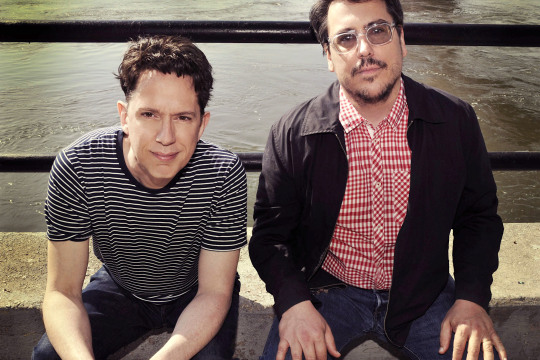
Q&A: They Might Be Giants Aren’t Just for Kids and Still Aren’t the Proclaimers
by Marc Spitz, Vanity Fair July 14, 2011
For almost 30 years, They Might Be Giants (John Flansburgh and John Linnell) have been releasing music that’s both snarky and sweet, morbid and whimsical, a little pop and a little avant-garde. Beginning in 2002, with the enhanced CD and book No!, they applied their sensibility to a trilogy of albums geared toward children. The shocking success of these (2005’s Here Come the ABCs went gold; 2008’s Here Come the 123s won a Grammy; 2009’s Here Comes Science was nominated) threatened to upstage everything else they did. The new album Join Us marks a return to their classic sound. While playful (the song “Cloisonne” features a singing raindrop), it is strictly for grown-ups. Here John Flansburgh (bespectacled John) discusses the band’s early years in Lower Manhattan, their struggle to win and keep casual fans, and why they’re not going to be walking 500 miles anytime soon.
___
Marc Spitz: They Might Be Giants came out of a downtown New York scene in the 80s that was very fashion friendly. And yet you weren’t embraced by that crowd in the same way as other bands were. It that because you were funny?
John Flansburgh: The thing about any scene is that it’s very hard to sum up for somebody who doesn’t know the scene. The constellations of things that are deemed to fit in or not fit in are just dictated by the people making the scene. We would play the Pyramid Club but we were considered the “rock band.” We were the nice boys who had the rock band. Half the acts that played the Pyramid Club were transvestites and they were also all on heroin so . . .
Marc Spitz: And you weren’t transvestites on heroin.
John Flansburgh: We weren’t transvestites on heroin. Even though we played with a drum machine. In the early days there was a lot more screaming in our shows. There was a histrionic quality to what we did. We started a couple of years after the No Wave movement, bands like DNA and Lydia Lunch. We were part of the first bunch of bands after that movement.
Marc Spitz: There were a couple of recent films about that period, one called Kill Your Idols and more recently, Blank City, which is about the cinema of the era. If you look at the commentators in both movies they’re still so put together. The hair and cheekbones thing. Like a New York City cartoon.
John Flansburgh: There was no mistaking what city you were in. And there was no end to the ambition of the people involved in it—people striving to be as original as they can possibly be. A lot of times people are just thinking about how to fit in. The East Village in the mid-80s was dominated by people thinking, What’s the most fucked-up thing I can do that won’t burn down the venue down. It was very much about phenomenon and causing an instant splash.
Marc Spitz: You and John (Linnell) have now built up a very successful career making records for children. My little niece loves them. Join Us opens with a lyric about a “town full of dicks” and contains a song titled “When Will You Die?” It seems almost reactionary, a signal that you’re back in adult-album mode. Are you?
John Flansburgh: I think we could have had a song on our first album called “When Will You Die?” Talking about death imagery in a very casual way is very They Might Be Giants.
Marc Spitz: Well this new one does seem like a classic TMBG record. Almost a reward for fans without children who may not listen to both sides of your output.
John Flansburgh: We just sort of institutionally split the two audiences from each other the second the kids’ stuff took off. We weren’t trying to figure out how to have a mixed career. Part of it was necessity. We were still playing clubs that might not have accommodations for people under 18. We had to tell people, “This is not for kids,” and be very clear about keeping them separate. If you like TMBG in general you’ll probably find pleasant things in the kids’ stuff. It’s very full-blooded. It’s not some reduced version of what we do.
Marc Spitz: I would imagine you could listen to both.
John Flansburgh: Conceivably you could. We don’t ask people to or expect people to.
Marc Spitz: Do you approach the songwriting differently?
John Flansburgh: That’s a very good question with a very complicated answer. I can tell you what the challenges are. Kids have the patience of a bug. You have to get their attention, and writing a song that’s immediate enough to capture their imagination is very demanding. It’s been difficult to turn away from [the children’s records]. Overnight we had a career as big as the one we’d been working on for 15 years. The truth of the matter is we’ve been chained to the kinder-rock desk for a couple of years now and we’re happy to get back to our roots. This is a kind of crucial time for us as a band - we really need to plant our freak flag in the ground and just be. We need to declare our independence a little bit, professionally. The kids’ stuff is interesting but it also has a sort of governor on it in terms of the kind of writing that we do. We love the things that we’ve made as a band.
Marc Spitz: They Might Be Giants is almost beyond a band. If someone says, “I’m a They Might Be Giants fan,” it often means something beyond one’s taste in music. Not that you don’t have any casual fans . . .
John Flansburgh: Our biggest professional aspiration is to have casual fans. If you’re doing something good, it shouldn’t be a cult thing. Being a cult implies some level of artistic failure. If it’s popular music you should enjoy it for what it is. When we played Bonnaroo, we had this little backstage area. We’re changing out of our sweaty clothes and there’s this knock at the door and a crazy drunk lady who somehow got backstage says, “I just gotta talk to you. I love you guys. I just gotta tell you I’ve been listening to your music my entire life. You’re my favorite band. I just wanna thank you. “500 Miles” got me through college.” And I’m like “500 Miles?” Then I realized she thought we were The Proclaimers.
___
Read the article on the Vanity Fair site here: https://www.vanityfair.com/culture/2011/07/they-might-be-giants-qa
58 notes
·
View notes
Text
Barbenheimer: Or, How I Learned to Stop Worrying and Love Moviegoing Again
When I first heard that Greta Gerwig's Barbie and Christopher Nolan's Oppenheimer were being released on the same day - July 21, 2023 - I didn't think much of it. After all, wildly disparate movies have been released on the same date before, and in an era before MCU/Disney dominated theaters, cineplexes had a variety of films that catered to many different audiences. The smash superhero sequel The Dark Knight and the ABBA-inspired musical comedy Mamma Mia! were both released on July 18, 2008, but social media was much less of a thing back then. (I've never seen Mamma Mia!, but my Dad and I did see TDK opening weekend.) Honestly? Initially, I didn't think people were really going to see both films on the same day, I thought people were joking. Boy was I wrong.
On their own, both films would have been hits with built-in audiences (love him or hate him, Nolan sure has dedicated fans). But by July 2023, the hype around the Barbenheimer phenomenon had gone nuclear. There were memes, T-shirts, and people bought tickets to see both movies in theaters on the same day, or at least the same weekend. The two have little in common, besides being high-profile studio films starring non-American actors as very American subjects, but that didn't matter.
On opening weekend, my friend and I saw a 70mm print of Oppenheimer on Saturday and a sold-out screening of Barbie on Sunday at the Village East theater in Manhattan, with a day break in-between. We had initially only planned to see the former, but even I was swept up by Barbie mania (I also enjoyed Gerwig's two previous films). There was an energy at the movie theater that I had not felt in a very long time outside of repertory cinema - people were genuinely excited to be there. When I was in line for the bathroom, a woman in front of me joked that you could tell who was there to see which movie. Lots of people in pink, Barbies and Kens abound, and even a few men (and one woman) dressed like J. Robert Oppenheimer, father of the atomic bomb. I did not dress up and I don't care much for the color pink, but it was still fun! It was a record-breaking box office weekend for both films - one a fantasy comedy about the world's most famous doll, the other a 3-hour doomy historical drama showing in premium large formats including IMAX. After a decade and a half of Marvel fare dominating theaters, this was a game-changer. Were superhero movies in their early '90s hair metal era?
I worked at a few movie theaters in suburban New Jersey in the 2000s, and this felt like a return to an era when word of mouth reigned supreme and people got dressed up for midnight screenings (people did this at a screening for one of the Harry Potter films, no lie). The hype also reminded me a bit of Titanic, which dominated the box office in 1997-98 when I was in 8th grade and everyone talked about it (weirdly enough, I did not see it until it was in a second run theater for some reason). But three years after the beginning of the pandemic, I was ready to go back to the movies - one of my favorite pastimes. I had seen a few films in theaters since 2022, once I was fully vaccinated and boosted, but this felt like a new beginning.
I enjoyed both movies and have now seen them twice (including an IMAX 70mm screening of Oppenheimer - if you have the opportunity to see it in this format, do it!). Barbie is charming and fun, with eye-popping production design and costumes and nods to directors like Jacques Demy. Margot Robbie (bringing humanity to a plastic doll) and Ryan Gosling are fantastic, and the film is a genuine crowd-pleaser. Oppenheimer is an intense, well-crafted drama with a few jaw-dropping sequences and a great, controlled performance by Cillian Murphy as Oppenheimer and a stacked cast. The editing by Jennifer Lame is phenomenal, and this might be the best work of Nolan's career. To date, Barbie has crossed the billion dollar mark worldwide, and Oppenheimer has made over $500 million globally - a huge deal for an R-rated talky period piece. Is this the beginning of better, more diverse movies in multiplexes across the world? Or just a weird fluke? Possibly the latter, but we'll see.
That said, the films aren't for everyone. I know people who have seen Barbie but have no interest in Oppenheimer, and that's okay! And if you don't care about either, I would recommend the documentary The Day After Trinity followed by Todd Haynes' Superstar: The Karen Carpenter Story as an alternative, at-home Barbenheimer. It's just nice to see people excited about going to the movies again.
4 notes
·
View notes
Text
En otro universo, pero su red lo conecta todo… “Madame Web”

Cassandra Webb, una paramédica de Manhattan que tiene poderes clarividentes, se ve obligada a enfrentar sucesos revelados en el pasado, mientras forja una relación con tres jóvenes destinadas a tener un futuro poderoso, las cuales están siendo perseguidas por un adversario mortal.
Estreno: 15 de febrero de 2024 en Cines.
youtube
Dirigida por S.J. Clarkson, la película cuenta con las actuaciones de Dakota Johnson, Sydney Sweeney, Isabela Merced, Celeste O'Connor, Emma Roberts, Mike Epps, Adam Scott y Tahar Rahim.
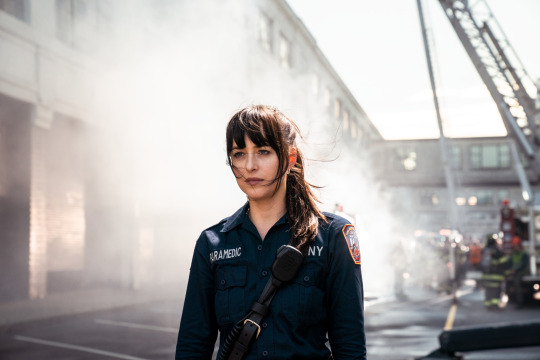

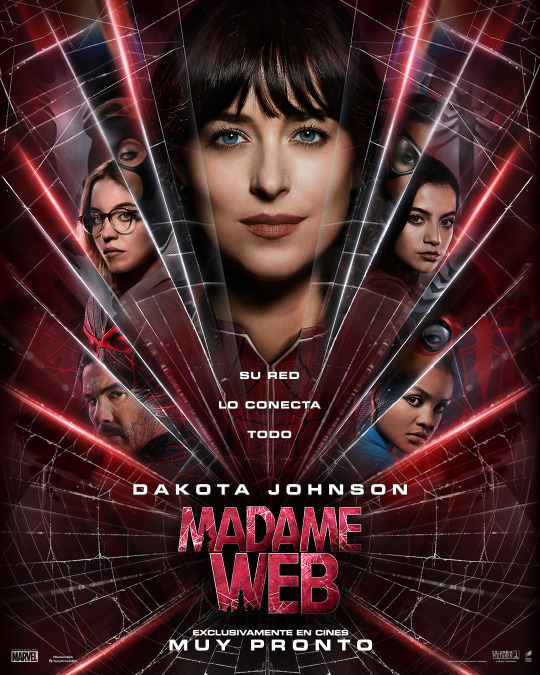
Detrás De Cámaras


Pósteres Individuales


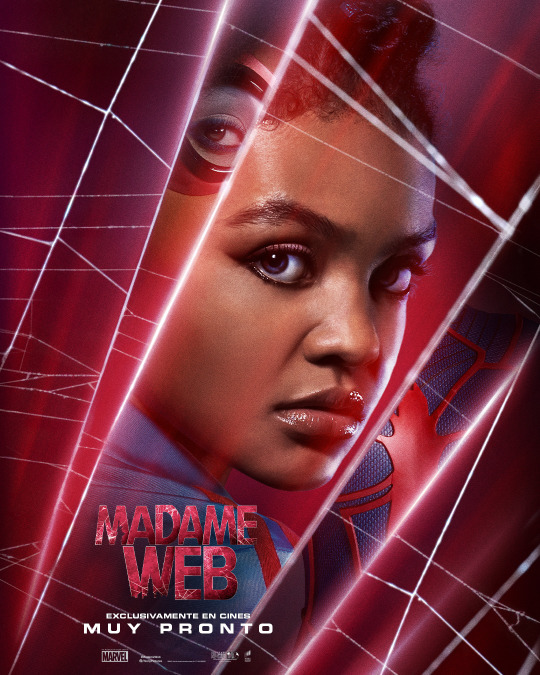
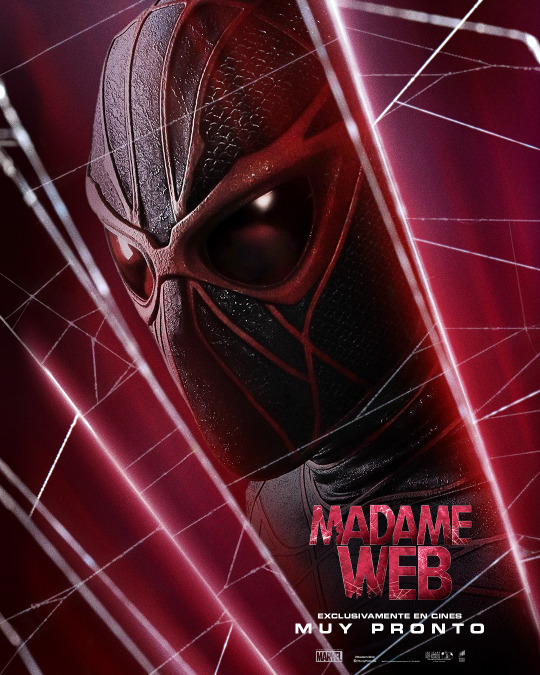

El elenco atendiendo la premiere mundial en el cinema Regency Village Westwood el 12 de febrero de 2024 en Los Ángeles, California
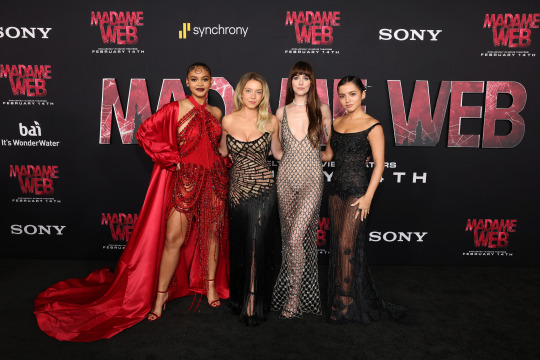

Dakota Johnson atendiendo la premiere de la película en el cinema Cinemex Antara Polanco el 13 de febrero de 2024 en la Ciudad de México



#Madame Web#Dakota Johnson#Sydney Sweeney#Isabela Merced#Celeste O'Connor#Emma Roberts#Mike Epps#Adam Scott#Tahar Rahim#Películas#Cines
1 note
·
View note
Text
Cinema Therapy
films
Tangled- Disney
Moana
Brave
Enchanted
Encanto
The Haunted Mansion
Coco
Mary Poppins 1,2
Inside Out
Frozen 1, 2
Hocus Pocus 1, 2
Beauty and the beast
Sleeping Beauty
The Aristocats
Barbie
Respect - Aretha Franklin
pretty woman
the parent trap
fireman Sam
Mathilda
Stuart little 1,2
13 going on 30
Harriet the spy
the mighty ducks series
Mean Girls
The Karate Kid, Cobra Kai
Bridget Jones 1-3
Penelope
Dirty Dancing
Scobby Doo live action films 1, 2
School of Rock
Moulin Rouge
fire heart
wolf walkers
Zoo
Dream Girls
Rocket Man
Sing 1, 2
Judy
Gone Girl
The Wind that Shakes the barley
Madeline
Smurfs the lost village
Thomas and Friends
Avathar the legend of Korra
Cat Woman
What a girl wants
The Perfect man
She's the man
Anastia
Masha and the Bear
Peter Pan
Beaches
Monster in law
Marry Me
Maid in Manhattan
Shrek, Puss in Boots series *
The Prince of Egypt *
Teenage Mutant Ninja turtles 2012
First Daughter
Spot Light
Mrs doubt fire *
The little rascals
Sinbad
Cheaper by the dozen
Titanic *
Freaky Friday- *
Peter Pan
Sister act
Never been kissed *
Ice Princess
Michael Collins
Cinderella *
A Cinderella story *
The Addams family
Harry Potter *
Shrek *
Kung fu panda *
How to train your dragon *
mean girls *
beauty and the beast *
1 note
·
View note
Text
Ghost Tours Are an Enjoyable Way to Check Out the Dark Side of Your Fave City
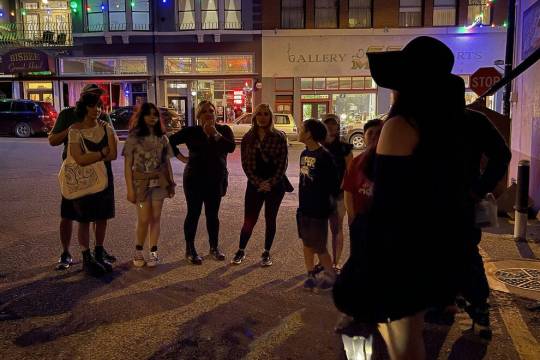
Haunted excursions are an enjoyable method to discover the darker side of your preferred city. Whether you're looking for a creepy walk via a historical community or a thrilling ride on the subway's ghost train, there's a tour to fit your tastes. Selecting a ghost trip can be challenging, as some are hefty on background while others lean more towards the paranormal. Learn more about Nashville Ghost Tours, go here. But the most crucial point is to locate one that fits your individual choices. The very best ghost trips will certainly give you a genuine experience of the location's creepy tales and historical facts. They'll additionally show you some of the city's most renowned landmarks as well as spooky places. If you want listening to some creepy tales, there are a lot of ghost excursions to pick from across the country. Some are extra lighthearted and also family-friendly, while others will terrify you right out of your skin. For instance, you can sign up with a candlelight trip via one of Manhattan's many haunted structures. Located in the Merchant's Residence Museum, this building was residence to the Tredwell family members for virtually 100 years. Throughout that time, seven family members passed away within its wall surfaces. On this candlelight ghost scenic tour, you'll listen to stories of uneasy spirits and supernatural events that happened to the people that lived there. You'll also get to see a few of your home's off-limits locations, like the servants' quarters. Throughout the trip, you'll additionally reach experience the current ghost hunting technology with a personal EMF detector. This equipment can aid you find ghosts in the most spooky places. If you're a fan of cinema, you can go on a ghost walk through Broadway's many haunted cinemas. The guides will certainly inform you a little concerning the creepy tales of the movie theaters, and also you can also sing along to some well-known songs from Broadway's darkest musicals. Then, you can experiment with a few of the devices that's been made use of on television programs and also movies to spot a ghost or spirit. These tours are frequently extra lighthearted than various other types of scenic tours, so they're best for families and also little ones. Find out for further details on Savannah Ghost Tours right here. Selecting a ghost scenic tour that's not as well terrifying can be the very best alternative for those that intend to get out and delight in the views of their preferred city without feeling terrified. Having to get out of your convenience area can be an exciting experience, and also the exhilaration you'll feel from strolling down scary streets will enhance your adrenaline degree as well as make the trip that a lot more satisfying. Another excellent ghost excursion to look into is the DISCOVER HISTORICAL GHOSTS New York City scenic tour, which sees 10 scary locations around the city. These locations include the haunted East Town, West Village, and also Greenwich Town, along with the previous Five Points location in downtown New york city. This trip is offered during daytime and also nighttime slots, but I assume it's a great deal a lot more creepy to take place the tour after dark. It's also a terrific choice if you're staying at an Airbnb in the East Town or if you're a vacationer checking out New York for the first time.
0 notes
Text
''DUET''
IL BELLISSIMO ''DUET'' DELLA MIA AMICA MIKA ORR CON CUI HO AVUTO IL PIACERE DI LAVORARE LO SCORSO ANNO E' STATO SELEZIONATO TRA I 100 CORTI DEL NEW YORK SHORT FILM FESTIVAL.... SARA' PROIETTATO INSIEME AD ALTRI 5 CORTOMETRAGGI AL CINEMA VILLAGE(22 E 12th St,NEW YORK,NY 100003)A MANHATTAN MERCOLEDI' 16 NOVEMBRE 2022 ALLE 20:00.
''DUET'' E' UN CORTOMETRAGGIO DI 21 MINUTI SU COME LE VITE DI DUE BAMBINE DI OTTO ANNI,MAY E SHADMIT,CHE NON SI PIACCIONO MOLTO,ALLA FINE SI INTRECCIANO PER SEMPRE.
https://vimeo.com/514782313/5018d9b4de?embedded=false&source=vimeo_logo&owner=2484201
0 notes
Text
New York - It's the most selective stair-climbing on the planet: New York's Metropolitan Museum of Art gala paraded hundreds of international stars in outlandish outfits at an annual philanthropic soiree on Monday night after two interrupted editions for the pandemic.
The "Met Gala 2022", in the heart of Manhattan, ended with an avalanche of images of stars responding to this year's dress code, "Gilded Glamour", in reference to the "Gilded Age", the American golden age of the late of the 19th century.
They happened in strapless dresses, tuxedos, ultra chic, hyper glamorous, sparkling, unlikely or even with political messages, on the steps of the Metropolitan Museum of Art (Met).
The list of 400 stars of fashion, music, cinema, social networks, politics or business, mostly American, was kept secret until the last moment. We saw Billie Eilish, Olivia Rodrigo, Cardi B, Megan Thee Stallion, Lenny Kravitz, Ariana DeBose, Sarah Jessica Parker, Gigi and Bella Hadid and Stromae who told AFP she found it "weird" to be there but felt " honored". , he the "little Belgian".
The richest man in the world, the capricious Elon Musk, raised his arms in front of the crowd. In the process of buying Twitter, he promised on the red carpet to make it the "most inclusive social network possible."
Hillary Clinton praised the "spirit of the United States" that permeated the gala. She is followed by actresses Glenn Close, Sigourney Weaver and Jessica Chastain.
First arrivals, YouTuber Emma Chamberlain appeared in a sublime Louis Vuitton dress and the event's high priestess, the almighty Vogue editor-in-chief Anna Wintour, in a Chanel ensemble.
Shawn Mendes courtesy of Tommy Hilfiger
"End of Guns"
The gala is also an occasion for a political message: New York Mayor Eric Adams landed in a jacket with his campaign slogan on the back demanding "an end to gun violence" in a city plagued by crime.
In true American philanthropic tradition, the evening, which takes place on the first Monday in May, is intended to finance the Met's fashion department (The Costume Institute) and coincides with its main annual exhibition. It was presented Monday morning to US First Lady Jill Biden, who saw in it "a celebration of the designers and fashion that have shaped America's true identity."
Make way this year for an American "Anthology of Fashion", a retrospective of the 19th and 20th centuries of a hundred garments reviewed by directors and designers such as Sofia Coppola, Martin Scorsese or Tom Ford.
American actress Blake Lively appeared in a striking strapless Versace dress with a large satin bow, revealing a print that paid homage to New York architecture. The gala took place when journalists and editors from Vogue and other Condé Nast titles (GQ, Vanity Fair, Glamour, etc.) launched a movement to create a union, which they remembered on social networks with a Vogue cover pastiche: “ Met Gala 2022 the longest night of the workers.
Kardashian in Marilyn
There have been fewer eccentricities on the red carpet than in years past: In 2019, singer-actor Billy Porter appeared as a sun god, unfurling golden wings and carried by men with muscular torsos. And no one has matched Lady Gaga and her striptease on the stairs.
However, Kim Kardashian, who appeared all in black (including her face) last September, closed this mega parade with a flourish: platinum blonde hair pulled back, molded in a shiny beige dress, a copy of the one she wore. Marilyn Monroe during her famous song "Happy Birthday, Mr. President," as the 60th anniversary of the global icon's death approaches.
Created in 1948, the Met Gala was for a long time reserved for New York's very high society, but Anna Wintour, who took over in 1995, transformed it into a "village" event adapted to the age of social networks. This year, the title of honorary co-chairman was also offered to Instagram boss Adam Mosseri, alongside Anna Wintour and stylist Tom Ford. (AFP)
0 notes
Text
Cinema Village

🗺 22 E 12th St, New York NY 10003
Reopened June 7, 2021.
🎟 https://cinemavillage.com/showtimes
Visited June 29, 2021
Concessions available.


📽 Back to Table of Contents
#cinema#film#movietheater#movie theater#nyc#new york#newyork#new york city#manhattan#cinema village#cinemavillage#movie theaters
0 notes
Photo
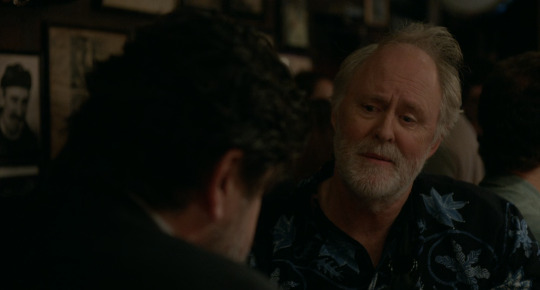



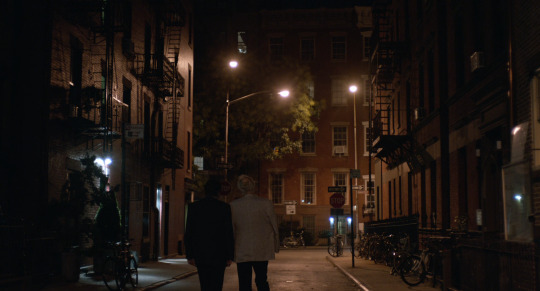
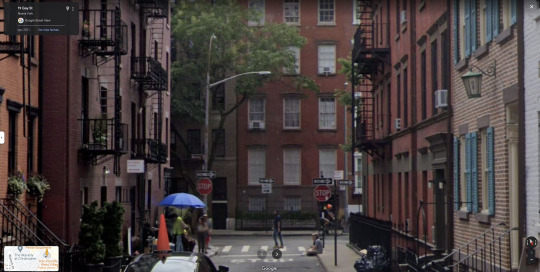
Love is Strange
Ira Sachs. 2014
Bar
Julius’. 159 W 10th St, New York, NY 10014, USA
Street
22-2 Gay St, New York, NY 10014, USA
See in map
See in imdb
#ira sachs#love is strange#john lithgow#alfred molina#greenwich village#manhattan#new york#movie#cinema#film#location#google maps#street view#2014
38 notes
·
View notes
Photo





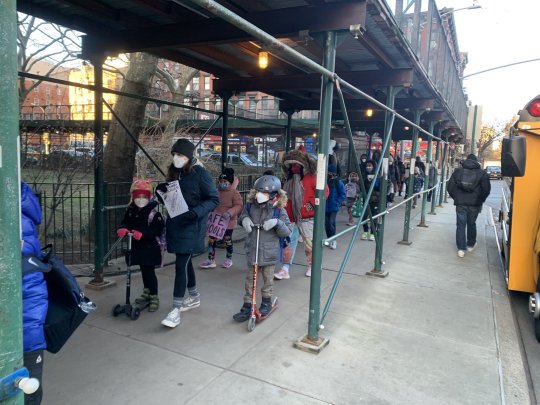
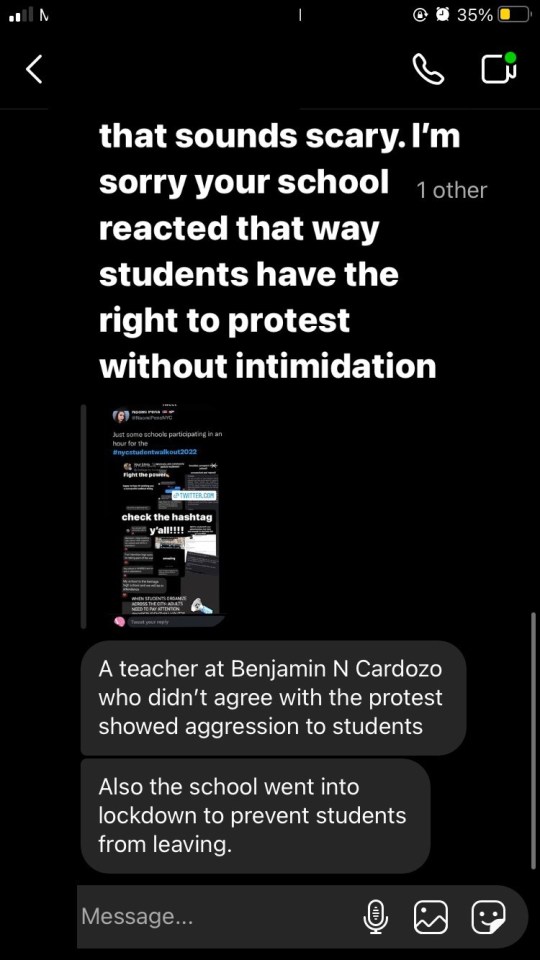
Scenes from the student walkout today in New York City, January 11, 2022. #StrikeForSafeSchools
"Our school conditions are not safe right now... there's so many people sick & our mayor is not doing enough to protect us. We want the option to go remote. We want the choice to keep our bodies safe." - Felicia, Bronx Science
The administration at Benjamin N. Cardozo High School locked down the campus so that students couldn't join the walkout. This is the procedure meant for "active shooter" situations.
Partial list of schools participating: Brooklyn Tech (NYC's largest high school); Lower East Side Prep; STAR Academy PS63 Stuyvesant HS; NESTM; Columbia Secondary School CSS; University Neighborhood High School; Brooklyn Prospect Charter School; Heritage High School; HS for law, advocacy and community justice; Bronx Science; Fort Hamilton HS; Digital Tech & Cinema Technology; The Young Women’s Leadership School Bronx; The Young Women’s Leadership School Queens; Sunset Park HS; WHEELS; Beacon; Art & Design; Mott Hall V; Talent Unlimited Manhattan Village Academy; BASE Bronx; Bronx Academy for Software and engineering; Fashion Industries; Belmont Preparatory HS
#StrikeForSafeSchools#SchoolsAreNotSafe#Omicron#pandemic#NYC#walkout#students#parents#teachers#protest#youth#healthcare#repression#Brooklyn#Bronx#Queens
50 notes
·
View notes
Photo

Q&A: They Might Be Giants Aren’t Just for Kids and Still Aren’t the Proclaimers
by Marc Spitz, Vanity Fair July 14, 2011
For almost 30 years, They Might Be Giants (John Flansburgh and John Linnell) have been releasing music that’s both snarky and sweet, morbid and whimsical, a little pop and a little avant-garde. Beginning in 2002, with the enhanced CD and book No!, they applied their sensibility to a trilogy of albums geared toward children. The shocking success of these (2005’s Here Come the ABCs went gold; 2008’s Here Come the 123s won a Grammy; 2009’s Here Comes Science was nominated) threatened to upstage everything else they did. The new album Join Us marks a return to their classic sound. While playful (the song “Cloisonne” features a singing raindrop), it is strictly for grown-ups. Here John Flansburgh (bespectacled John) discusses the band’s early years in Lower Manhattan, their struggle to win and keep casual fans, and why they’re not going to be walking 500 miles anytime soon.
___
Marc Spitz: They Might Be Giants came out of a downtown New York scene in the 80s that was very fashion friendly. And yet you weren’t embraced by that crowd in the same way as other bands were. It that because you were funny?
John Flansburgh: The thing about any scene is that it’s very hard to sum up for somebody who doesn’t know the scene. The constellations of things that are deemed to fit in or not fit in are just dictated by the people making the scene. We would play the Pyramid Club but we were considered the “rock band.” We were the nice boys who had the rock band. Half the acts that played the Pyramid Club were transvestites and they were also all on heroin so . . .
Marc Spitz: And you weren’t transvestites on heroin.
John Flansburgh: We weren’t transvestites on heroin. Even though we played with a drum machine. In the early days there was a lot more screaming in our shows. There was a histrionic quality to what we did. We started a couple of years after the No Wave movement, bands like DNA and Lydia Lunch. We were part of the first bunch of bands after that movement.
Marc Spitz: There were a couple of recent films about that period, one called Kill Your Idols and more recently, Blank City, which is about the cinema of the era. If you look at the commentators in both movies they’re still so put together. The hair and cheekbones thing. Like a New York City cartoon.
John Flansburgh: There was no mistaking what city you were in. And there was no end to the ambition of the people involved in it—people striving to be as original as they can possibly be. A lot of times people are just thinking about how to fit in. The East Village in the mid-80s was dominated by people thinking, What’s the most fucked-up thing I can do that won’t burn down the venue down. It was very much about phenomenon and causing an instant splash.
Marc Spitz: You and John (Linnell) have now built up a very successful career making records for children. My little niece loves them. Join Us opens with a lyric about a “town full of dicks” and contains a song titled “When Will You Die?” It seems almost reactionary, a signal that you’re back in adult-album mode. Are you?
John Flansburgh: I think we could have had a song on our first album called “When Will You Die?” Talking about death imagery in a very casual way is very They Might Be Giants.
Marc Spitz: Well this new one does seem like a classic TMBG record. Almost a reward for fans without children who may not listen to both sides of your output.
John Flansburgh: We just sort of institutionally split the two audiences from each other the second the kids’ stuff took off. We weren’t trying to figure out how to have a mixed career. Part of it was necessity. We were still playing clubs that might not have accommodations for people under 18. We had to tell people, “This is not for kids,” and be very clear about keeping them separate. If you like TMBG in general you’ll probably find pleasant things in the kids’ stuff. It’s very full-blooded. It’s not some reduced version of what we do.
Marc Spitz: I would imagine you could listen to both.
John Flansburgh: Conceivably you could. We don’t ask people to or expect people to.
Marc Spitz: Do you approach the songwriting differently?
John Flansburgh: That’s a very good question with a very complicated answer. I can tell you what the challenges are. Kids have the patience of a bug. You have to get their attention, and writing a song that’s immediate enough to capture their imagination is very demanding. It’s been difficult to turn away from [the children’s records]. Overnight we had a career as big as the one we’d been working on for 15 years. The truth of the matter is we’ve been chained to the kinder-rock desk for a couple of years now and we’re happy to get back to our roots. This is a kind of crucial time for us as a band - we really need to plant our freak flag in the ground and just be. We need to declare our independence a little bit, professionally. The kids’ stuff is interesting but it also has a sort of governor on it in terms of the kind of writing that we do. We love the things that we’ve made as a band.
Marc Spitz: They Might Be Giants is almost beyond a band. If someone says, “I’m a They Might Be Giants fan,” it often means something beyond one’s taste in music. Not that you don’t have any casual fans . . .
John Flansburgh: Our biggest professional aspiration is to have casual fans. If you’re doing something good, it shouldn’t be a cult thing. Being a cult implies some level of artistic failure. If it’s popular music you should enjoy it for what it is. When we played Bonnaroo, we had this little backstage area. We’re changing out of our sweaty clothes and there’s this knock at the door and a crazy drunk lady who somehow got backstage says, “I just gotta talk to you. I love you guys. I just gotta tell you I’ve been listening to your music my entire life. You’re my favorite band. I just wanna thank you. “500 Miles” got me through college.” And I’m like “500 Miles?” Then I realized she thought we were The Proclaimers.
___
Read the article on the Vanity Fair site here: https://www.vanityfair.com/culture/2011/07/they-might-be-giants-qa
20 notes
·
View notes
Text
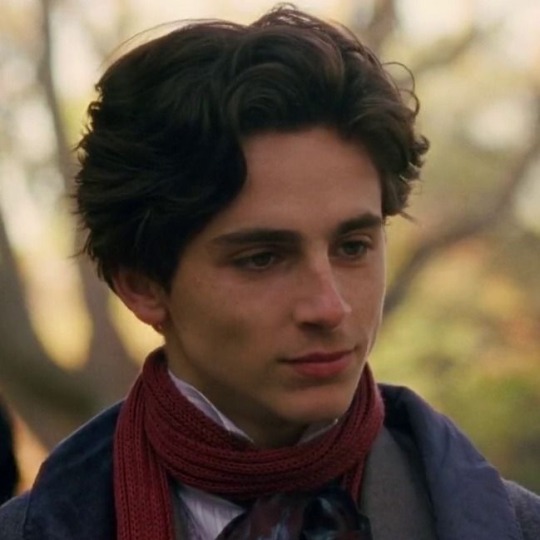
PART 5
Hello sweethearts:)
Next part (part 6) will be the last one. It will be a long one and very cozy and christmassy and romantic. Please let me know if you are reading these, it motivates me a lot to write more. Maybe I’ll start a new series!
Xxxx Murphy
Timmy POV
I was sitting on the corner of her bed when she woke up.
I was surprised she didn’t flinch when she noticed me, there was no trace of fear to be found. It pleased me. I gave her a smile. When you have had an entire night to overthink the possibility of having lost someone you love there is a glossiness on their presence and a gratitude in seeing them do simple things, like breathing or hear their voice. I had been mad at her too but these feelings had dissolved completely when I saw her face in that hotel in Manhattan.
‘Ready?’ I asked.
‘Hell yes.’ Her voice was raspy but her eyes were bright and awake.
‘Good.’ I said and stood up. ‘Do you want coffee here or get some outside?’
‘Outside’
‘Excellent choice’
She chuckled and made a motion with her hand to tell me to get out of the room to let her change.
‘I’m going I’m going.’ I walked out and got into my jacket and a scarf. There were two gloves laying on the heater in the same color as the hat I’d given her. I wondered if she’d brought them from home or bought them in the city.
‘You can keep the hat if you want’ I told her when she joined me at the door. She just shook her head and tousled my hair.
‘You’re too good for this world Timmy I mean it.’
I just laughed and looked at the floor.
****
It was raining outside, too early for the snow to be lasting. It would come back in a couple of weeks.
We walked around Central Park with our coffees and I told her stories I had memorized, inside information about the history of the park. When Zendaya pointed to an information board in the northwest part of the park I told her the story of Seneca village.
I told her that in the 1820s when Central Park was yet to be put into existence most people lived in lower Manhattan, but after the abolition of slavery and a shortage in jobs it became unsafe for free black people to live in this area. They moved uptown to the hilly countryside and bought a piece of land and named it Seneca village. It soon became an integrated community. People of all ethnicities seemed to get along and through archeological findings it also seemed like the village was quite rich.
Unfortunately as the development of Central Park started the village got destroyed and its history forgotten until recent archeological excavations.
‘Imagine how many poc families would be in upper class by now if their properties weren’t demolished’ zendaya said after I finished talking.
‘Yeah crazy right.’
‘It’s weird to walk here now I know this. It feels like walking through something sacred.’
***
After Central Park I showed her my favorite pizza place, stone oven and hand made. We ate and talked and afterwards I brought her to a small cinema I used to come as a kid and we went in to watch a screening of lady bird. Halfway through the film Zendaya put her head on my shoulder. She didn’t say anything and I didn’t object. I wanted to wrap my arms around her so badly and interlace my fingers with hers but I didn’t move. I was glad we were close again and reminded myself I could never ask for more then friendship.
The next day Zendaya left to go home to LA. I was sulky and called some friends to spent the rest of the week with them instead of feeling sorry for myself and being on my own.
Zendaya and I didn’t talk a lot the following month, just a few how are you’s over text but then december came and my phone rang. I was in London at the time in a taxi and it was pouring outside making it hard for me to understand what she was trying to tell me.
‘Tom and I we.... I... it’s not fair to him. We had a great time but I had to tell him. I told him it’s over.’ She was rambling and talking so fast I had to fill in a lot of gaps. Did I hear this correctly or was I making this up. How could this have happened? They were so invested in eachother. Or at least I’d told myself this over and over.
‘Are you okay?’ I asked.
‘I’m good, yes. Where are you, what’s that noise.’
‘London, it’s raining.’
‘Ah. Too bad.’
‘Why?’
‘Oh nothing.’
I smiled. ‘Okay...’
‘Well actually I thought maybe I could come visit again? I miss New York and I need to get out of LA...’
‘Yes of course Zee.’
‘When can I come?’
‘I’ll be back next week but I have to return my uncles car that I borrowed, he lives in Vermont so it’ll be a bit of a drive. I’m not sure when I’ll be back from that, probably just before Christmas.’
She was quiet for a bit as though she was contemplating this. “Can I come?”
‘To Vermont?’
‘.....yes.’
‘Sure, yes of course.’
‘How long are we in the car for?’
‘Six hours or so, so we should probably crash there.’
‘Oh jezus.’
‘Yes it’s up north quite a bit.’
‘Won’t your uncle mind?.’
‘He lives in a huge cabin it won’t be a problem.’
‘Okay sounds like an adventure.’
‘It sure will be.’
@lonely-simp @daya1and1timo
TO BE CONTINUED
#timothee chalamet#timothee x reader#timothëe chalamet fanfic#zendaya x timothée#roger taylor fanfic#roger taylor imagine#roger taylor x reader#ben hardy imagine#timmy#timmytim#timothée x zendaya#timothée chalamet x zendaya#timothée zendaya
34 notes
·
View notes
Text
Jason G. Ryan McGinley mini research paper

Jake (Cannes) 2005 - Sun and Health

Self Portrait (Polaroids) 1999 - The kids are alright
Jason A. Goodwin
11 November 2021
Ryan McGinley: The Kids Are Alright / Sun & Health
Ryan McGinley was born in 1977 In Ramseys, New Jersey, the youngest of eight children. Ryan was drawn to a cast of graffiti artists, skateboarders, and musicians who were "outsiders" on the fringe of society's mainstream. In 1997 he enrolled at Parsons School of Design with a focus in graphic design. McGinley lived in Manhattan's East Village neighborhood throughout his formative years as an artist. This downtown influence can be directly correlated to his first collection of images; The Kids are alright.
These images were curated in a self-made photo book published by the artist in 1999. The series began as spontaneous, candid shots of his friends and the group's lifestyle. These snapshot images turned into a slice of life series. That became known as "iconic snapshots of a generation," as stated by the Whitney Museum, who picked up the series in 2003. McGinley's work became a part of their First Exposure series, making McGinley the youngest artist to have a solo exhibition at the institution at age twenty-five. The series depicts young, sometimes nude, beautiful kids performing acts like raving, smoking, running, jumping, and shoplifting. Sylvia Wolf picked up and organized McGinley's solo exhibition at the Whitney. Wolf wrote said the following about McGinley in an essay "The skateboarders, musicians, graffiti artists and gay people in Mr. McGinley's early work 'know what it means to be photographed. [...] They are savvy about visual culture, acutely aware of how identity can be not only communicated but created. They are willing collaborators." Rebellion is a word that comes to mind when thinking of ways to describe the series. I will be putting The Kids are alright in conversation with McGinleys junior series Sun and Health (2006) a more constructed series with his subjects knowingly taking part in the creation of a image whereas in his earlier work has a more spontaneous, immediate, snapshot feeling.
Sun and Health is a series similar to The Kids are alright with a different attitude. The similarity in style comes from McGinley's familiarity with his subjects. McGinley photographed the project over summer road trips as he traveled across the United States, capturing his friends, sometimes nude with natural backdrops of nature and light behind them. McGinley is orchestrating scenes according to his creative vision. Since 2004, McGinley's style has evolved from documenting his friends in real-life situations towards creating envisioned situations that can be photographed. In 2007, critic Philip Gefter wrote, "He was a fly on the wall. But then he began to direct the activities, photographing his subjects in a cinema-verite mode." McGinley is photographing his friends still in a carefree, liberated fashion. Still, they engage in boating, rolling down dunes, and running through open fields. This series Sun and Health has turned into an annual occasion for the artist. In conversation with filmmaker Gus Van Sant, McGinley described his practice of making photographs on the road "Such a big part of what I do is removing myself and other people from the city—taking people to these beautiful and remote locations, being together for long periods of time, getting that intimacy, and doing all these intense activities together every day. In a way, it's like a bizarre summer camp or like touring in a rock band or traveling circus. It's all those things combined. Just taking everyone out of their element so you have their full attention."
In The Kids Are Alright, McGinley's intimate photographs are framed in self-discovery, free from shame or labels. For example, Self Portrait (Polaroids) 1999 is a photograph of McGinley and a friend nude on a bed with a wall of polaroids behind them. A wall of visitors that have come through the artist's apartment. The way McGinley is piled atop his friend feels like it was done in a cheerful self-awareness that reduces the sexuality of his image, allowing them to be viewed as honest, not pornographic or voyeuristic. This image beautifully illustrates McGinley's ability to capture a sense of liberation and indulgence in his early work, which attracted the attention of a more buttoned-up and formal art world.
Sun and Health has a similar process to the realization of The Kids are Alright. McGinley shot his friends with some images more staged than others while traveling across the country in the summer of two thousand five. This series feels equally liberating and joyous as The Kids are Alright, if not more. The color is rich, and the photographs have a sense of movement that leans into the carefree youthful feeling that felt like a focus in Mcginleys freshman series. The subjects are photographed nude as they frolic through fields and swim in lakes captured by McGinley with softness and respect that feels mutual and similar to his previous work. One photograph that spoke to me is the "Jake (Cannes)" from the series. The image is a moment captured of McGinley's friend Jake climbing a ladder emerging from the water with a twisted look on his face. I found that the two series are closely connected with a slight change of point of view. Sun and Health feels more controlled and planned with where The Kids are alright had a quick and spontaneous feeling.
Bibliography
Gefter, Philip. “A Young Man with an Eye, and Friends up a Tree.” The New York Times, The New York Times, 6 May 2007, https://www.nytimes.com/2007/05/06/arts/design/06geft.html.
“Gus Van Sant, 2012.” RYAN McGINLEY, https://ryanmcginley.com/gus-van-sant-2012.
“Sylvia Wolf, 2012.” RYAN McGINLEY, https://ryanmcginley.com/sylvia-wolf-2012.
6 notes
·
View notes